Clinical Decision Support: Types, Triggers, and Outcomes in Healthcare
VerifiedAdded on 2022/08/24
|6
|1029
|16
Report
AI Summary
This report delves into the realm of Clinical Decision Support Systems (CDSS) within healthcare. It begins by defining CDSS and highlighting its role in enhancing healthcare quality by reducing errors. The report then explores different types of CDSS, including solicited and unsolicited information systems, and physician order information, citing examples like MYCIN and CPOE. It identifies triggers for CDSS activation, such as medication administration or test requests, and discusses who, what, when, and how instructions. Finally, the report examines the outcomes of CDSS, emphasizing the need for high-quality studies to develop performance predictors and improve medication efficiency. The impact on health, humanistic, and economic outcomes is also discussed, along with the importance of considering quality mediators based on Donabedian's framework.
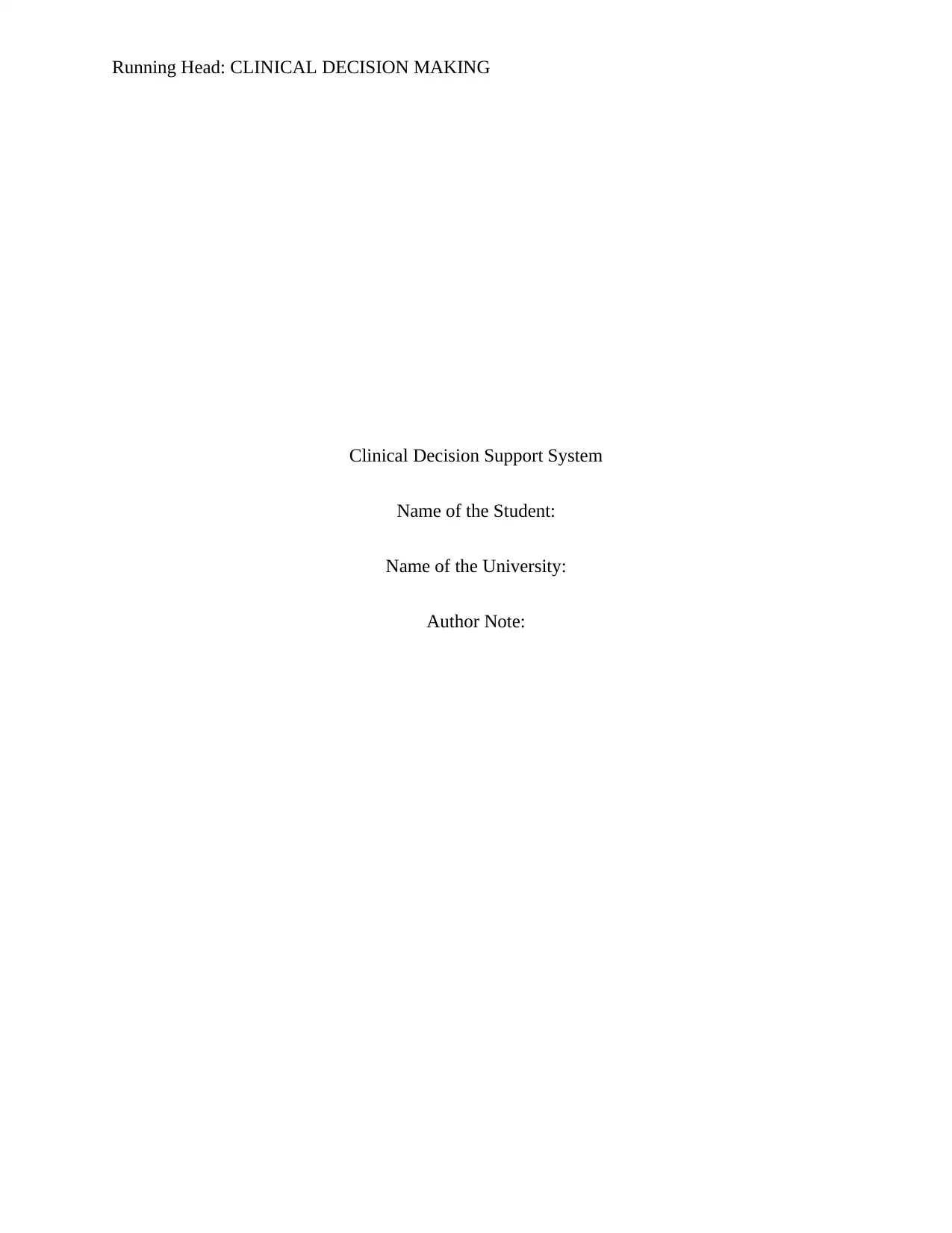
Running Head: CLINICAL DECISION MAKING
Clinical Decision Support System
Name of the Student:
Name of the University:
Author Note:
Clinical Decision Support System
Name of the Student:
Name of the University:
Author Note:
Paraphrase This Document
Need a fresh take? Get an instant paraphrase of this document with our AI Paraphraser
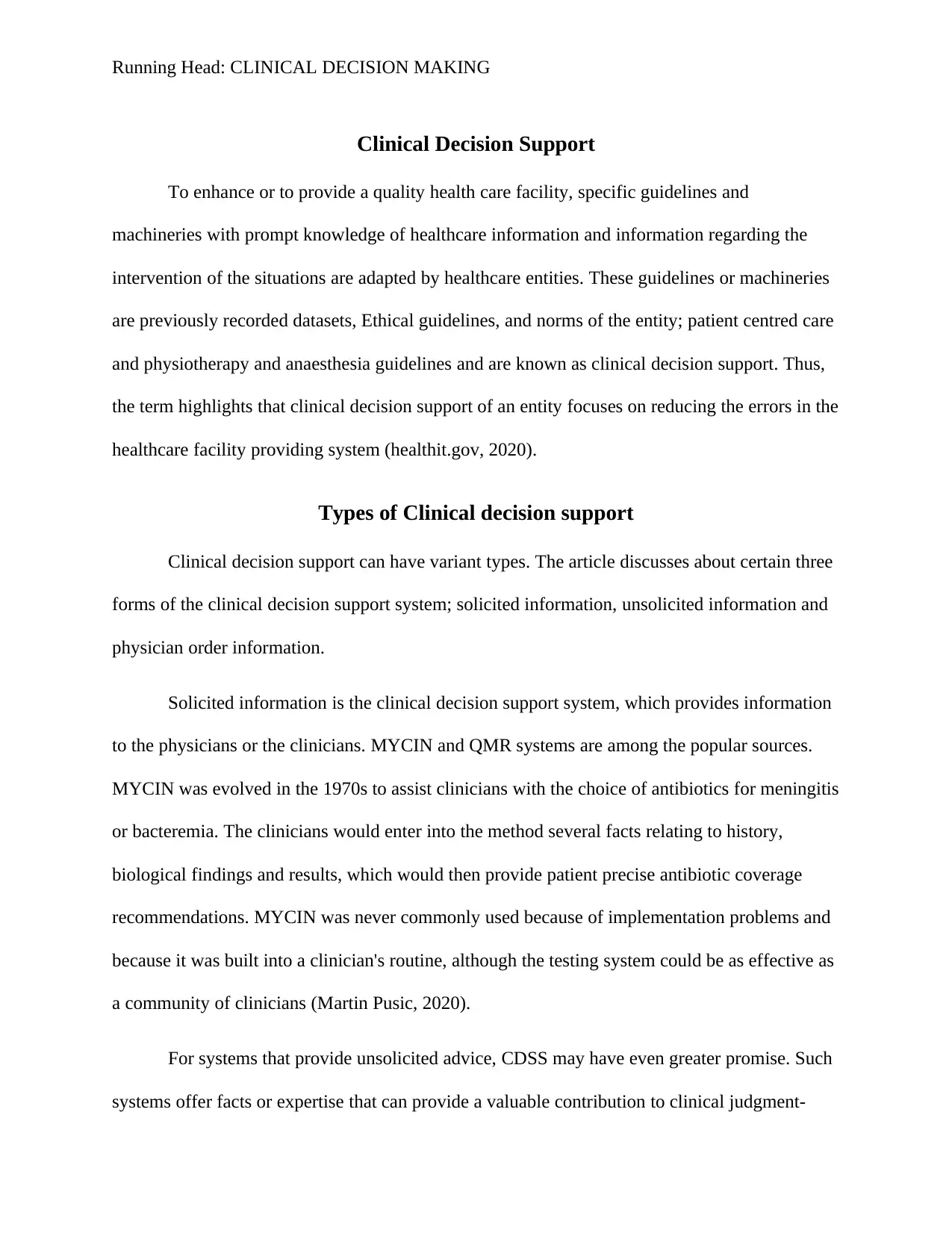
Running Head: CLINICAL DECISION MAKING
Clinical Decision Support
To enhance or to provide a quality health care facility, specific guidelines and
machineries with prompt knowledge of healthcare information and information regarding the
intervention of the situations are adapted by healthcare entities. These guidelines or machineries
are previously recorded datasets, Ethical guidelines, and norms of the entity; patient centred care
and physiotherapy and anaesthesia guidelines and are known as clinical decision support. Thus,
the term highlights that clinical decision support of an entity focuses on reducing the errors in the
healthcare facility providing system (healthit.gov, 2020).
Types of Clinical decision support
Clinical decision support can have variant types. The article discusses about certain three
forms of the clinical decision support system; solicited information, unsolicited information and
physician order information.
Solicited information is the clinical decision support system, which provides information
to the physicians or the clinicians. MYCIN and QMR systems are among the popular sources.
MYCIN was evolved in the 1970s to assist clinicians with the choice of antibiotics for meningitis
or bacteremia. The clinicians would enter into the method several facts relating to history,
biological findings and results, which would then provide patient precise antibiotic coverage
recommendations. MYCIN was never commonly used because of implementation problems and
because it was built into a clinician's routine, although the testing system could be as effective as
a community of clinicians (Martin Pusic, 2020).
For systems that provide unsolicited advice, CDSS may have even greater promise. Such
systems offer facts or expertise that can provide a valuable contribution to clinical judgment-
Clinical Decision Support
To enhance or to provide a quality health care facility, specific guidelines and
machineries with prompt knowledge of healthcare information and information regarding the
intervention of the situations are adapted by healthcare entities. These guidelines or machineries
are previously recorded datasets, Ethical guidelines, and norms of the entity; patient centred care
and physiotherapy and anaesthesia guidelines and are known as clinical decision support. Thus,
the term highlights that clinical decision support of an entity focuses on reducing the errors in the
healthcare facility providing system (healthit.gov, 2020).
Types of Clinical decision support
Clinical decision support can have variant types. The article discusses about certain three
forms of the clinical decision support system; solicited information, unsolicited information and
physician order information.
Solicited information is the clinical decision support system, which provides information
to the physicians or the clinicians. MYCIN and QMR systems are among the popular sources.
MYCIN was evolved in the 1970s to assist clinicians with the choice of antibiotics for meningitis
or bacteremia. The clinicians would enter into the method several facts relating to history,
biological findings and results, which would then provide patient precise antibiotic coverage
recommendations. MYCIN was never commonly used because of implementation problems and
because it was built into a clinician's routine, although the testing system could be as effective as
a community of clinicians (Martin Pusic, 2020).
For systems that provide unsolicited advice, CDSS may have even greater promise. Such
systems offer facts or expertise that can provide a valuable contribution to clinical judgment-
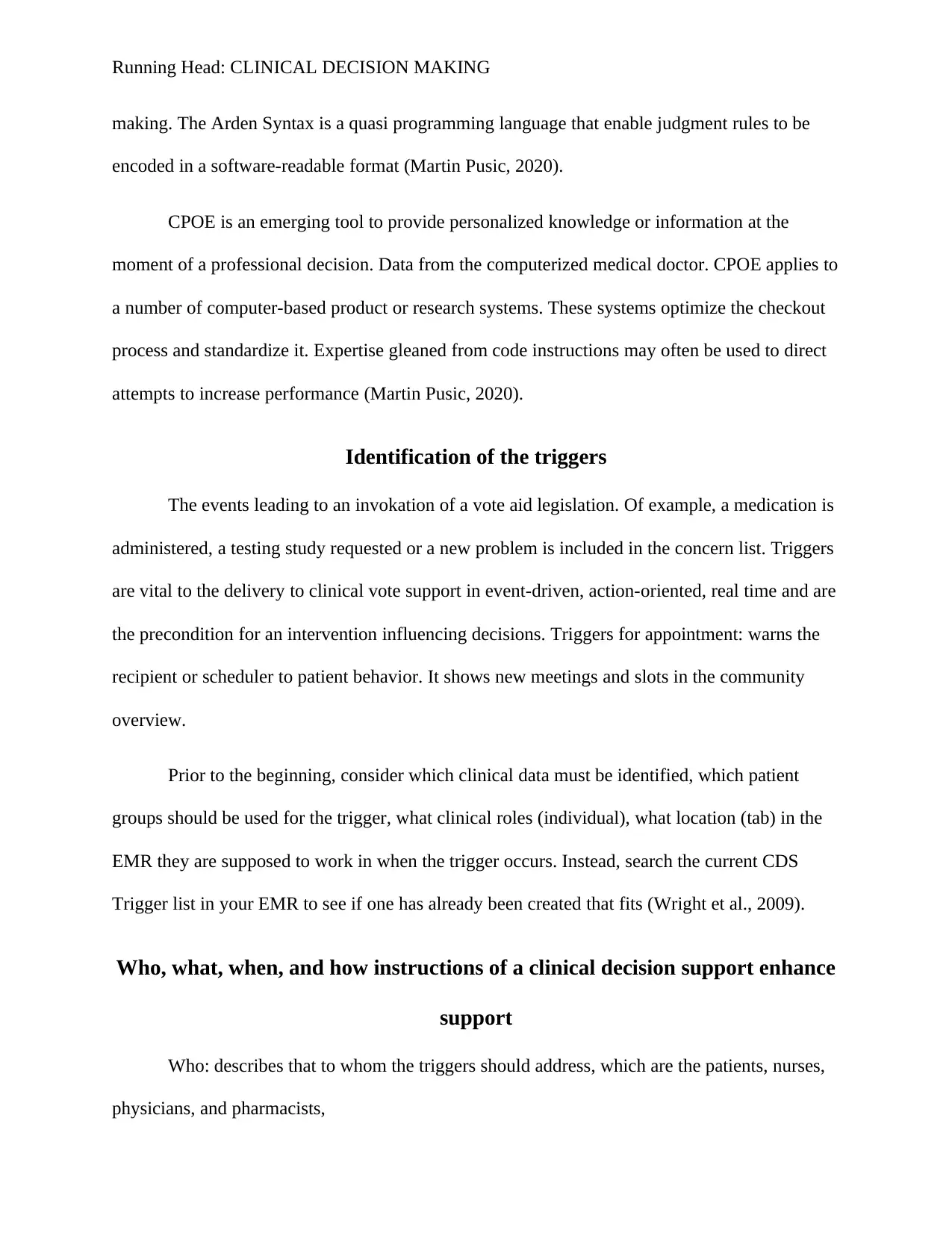
Running Head: CLINICAL DECISION MAKING
making. The Arden Syntax is a quasi programming language that enable judgment rules to be
encoded in a software-readable format (Martin Pusic, 2020).
CPOE is an emerging tool to provide personalized knowledge or information at the
moment of a professional decision. Data from the computerized medical doctor. CPOE applies to
a number of computer-based product or research systems. These systems optimize the checkout
process and standardize it. Expertise gleaned from code instructions may often be used to direct
attempts to increase performance (Martin Pusic, 2020).
Identification of the triggers
The events leading to an invokation of a vote aid legislation. Of example, a medication is
administered, a testing study requested or a new problem is included in the concern list. Triggers
are vital to the delivery to clinical vote support in event-driven, action-oriented, real time and are
the precondition for an intervention influencing decisions. Triggers for appointment: warns the
recipient or scheduler to patient behavior. It shows new meetings and slots in the community
overview.
Prior to the beginning, consider which clinical data must be identified, which patient
groups should be used for the trigger, what clinical roles (individual), what location (tab) in the
EMR they are supposed to work in when the trigger occurs. Instead, search the current CDS
Trigger list in your EMR to see if one has already been created that fits (Wright et al., 2009).
Who, what, when, and how instructions of a clinical decision support enhance
support
Who: describes that to whom the triggers should address, which are the patients, nurses,
physicians, and pharmacists,
making. The Arden Syntax is a quasi programming language that enable judgment rules to be
encoded in a software-readable format (Martin Pusic, 2020).
CPOE is an emerging tool to provide personalized knowledge or information at the
moment of a professional decision. Data from the computerized medical doctor. CPOE applies to
a number of computer-based product or research systems. These systems optimize the checkout
process and standardize it. Expertise gleaned from code instructions may often be used to direct
attempts to increase performance (Martin Pusic, 2020).
Identification of the triggers
The events leading to an invokation of a vote aid legislation. Of example, a medication is
administered, a testing study requested or a new problem is included in the concern list. Triggers
are vital to the delivery to clinical vote support in event-driven, action-oriented, real time and are
the precondition for an intervention influencing decisions. Triggers for appointment: warns the
recipient or scheduler to patient behavior. It shows new meetings and slots in the community
overview.
Prior to the beginning, consider which clinical data must be identified, which patient
groups should be used for the trigger, what clinical roles (individual), what location (tab) in the
EMR they are supposed to work in when the trigger occurs. Instead, search the current CDS
Trigger list in your EMR to see if one has already been created that fits (Wright et al., 2009).
Who, what, when, and how instructions of a clinical decision support enhance
support
Who: describes that to whom the triggers should address, which are the patients, nurses,
physicians, and pharmacists,
⊘ This is a preview!⊘
Do you want full access?
Subscribe today to unlock all pages.

Trusted by 1+ million students worldwide
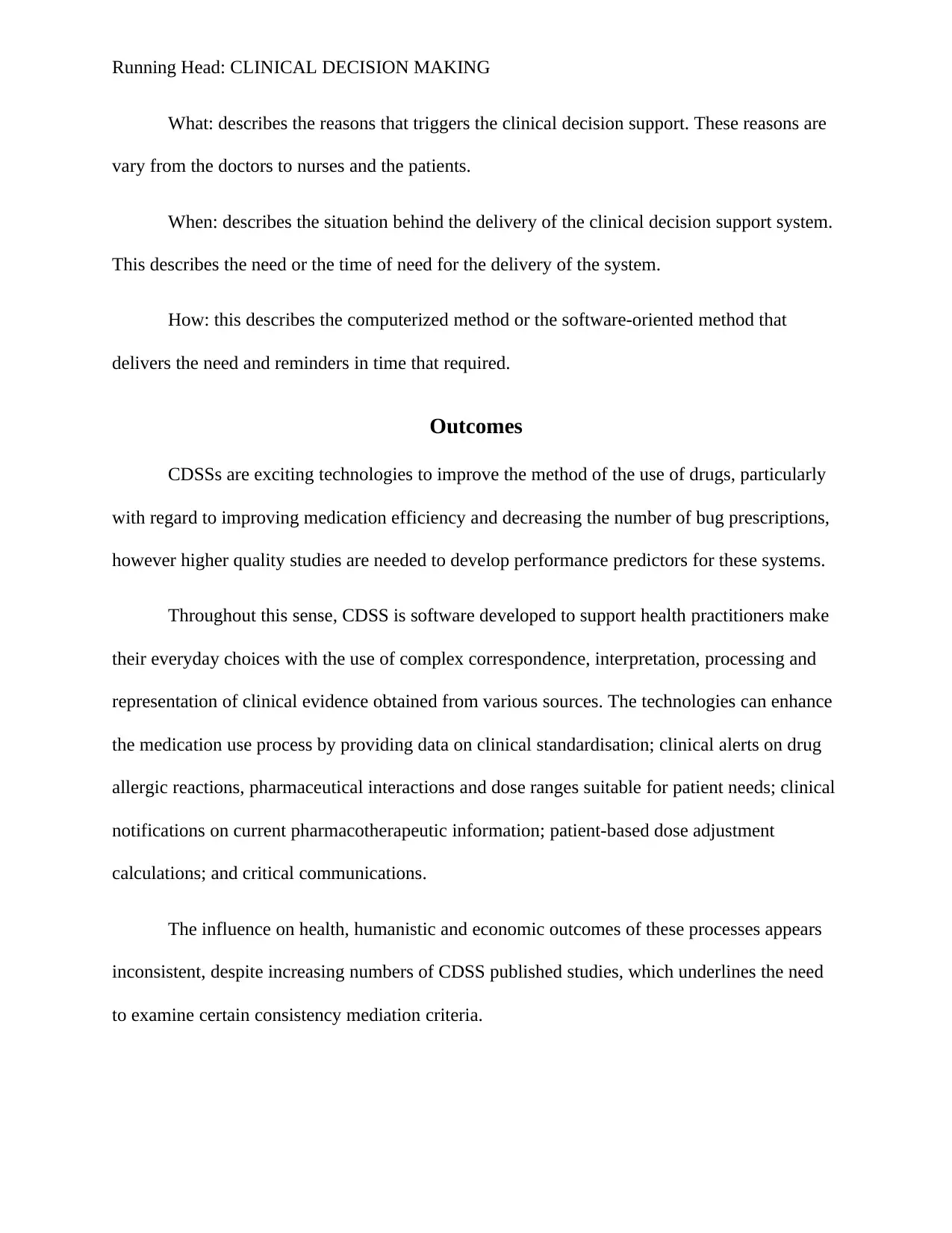
Running Head: CLINICAL DECISION MAKING
What: describes the reasons that triggers the clinical decision support. These reasons are
vary from the doctors to nurses and the patients.
When: describes the situation behind the delivery of the clinical decision support system.
This describes the need or the time of need for the delivery of the system.
How: this describes the computerized method or the software-oriented method that
delivers the need and reminders in time that required.
Outcomes
CDSSs are exciting technologies to improve the method of the use of drugs, particularly
with regard to improving medication efficiency and decreasing the number of bug prescriptions,
however higher quality studies are needed to develop performance predictors for these systems.
Throughout this sense, CDSS is software developed to support health practitioners make
their everyday choices with the use of complex correspondence, interpretation, processing and
representation of clinical evidence obtained from various sources. The technologies can enhance
the medication use process by providing data on clinical standardisation; clinical alerts on drug
allergic reactions, pharmaceutical interactions and dose ranges suitable for patient needs; clinical
notifications on current pharmacotherapeutic information; patient-based dose adjustment
calculations; and critical communications.
The influence on health, humanistic and economic outcomes of these processes appears
inconsistent, despite increasing numbers of CDSS published studies, which underlines the need
to examine certain consistency mediation criteria.
What: describes the reasons that triggers the clinical decision support. These reasons are
vary from the doctors to nurses and the patients.
When: describes the situation behind the delivery of the clinical decision support system.
This describes the need or the time of need for the delivery of the system.
How: this describes the computerized method or the software-oriented method that
delivers the need and reminders in time that required.
Outcomes
CDSSs are exciting technologies to improve the method of the use of drugs, particularly
with regard to improving medication efficiency and decreasing the number of bug prescriptions,
however higher quality studies are needed to develop performance predictors for these systems.
Throughout this sense, CDSS is software developed to support health practitioners make
their everyday choices with the use of complex correspondence, interpretation, processing and
representation of clinical evidence obtained from various sources. The technologies can enhance
the medication use process by providing data on clinical standardisation; clinical alerts on drug
allergic reactions, pharmaceutical interactions and dose ranges suitable for patient needs; clinical
notifications on current pharmacotherapeutic information; patient-based dose adjustment
calculations; and critical communications.
The influence on health, humanistic and economic outcomes of these processes appears
inconsistent, despite increasing numbers of CDSS published studies, which underlines the need
to examine certain consistency mediation criteria.
Paraphrase This Document
Need a fresh take? Get an instant paraphrase of this document with our AI Paraphraser
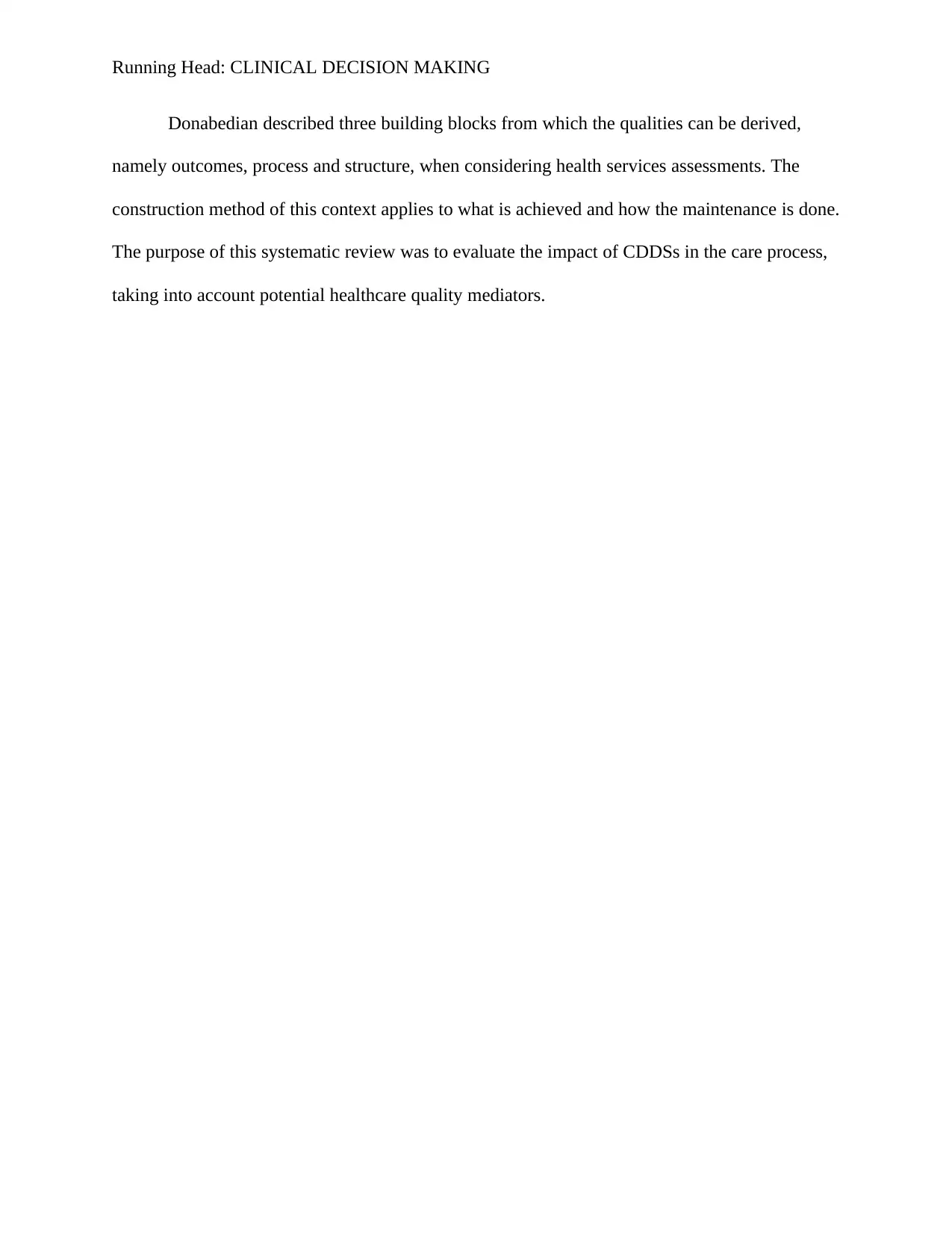
Running Head: CLINICAL DECISION MAKING
Donabedian described three building blocks from which the qualities can be derived,
namely outcomes, process and structure, when considering health services assessments. The
construction method of this context applies to what is achieved and how the maintenance is done.
The purpose of this systematic review was to evaluate the impact of CDDSs in the care process,
taking into account potential healthcare quality mediators.
Donabedian described three building blocks from which the qualities can be derived,
namely outcomes, process and structure, when considering health services assessments. The
construction method of this context applies to what is achieved and how the maintenance is done.
The purpose of this systematic review was to evaluate the impact of CDDSs in the care process,
taking into account potential healthcare quality mediators.
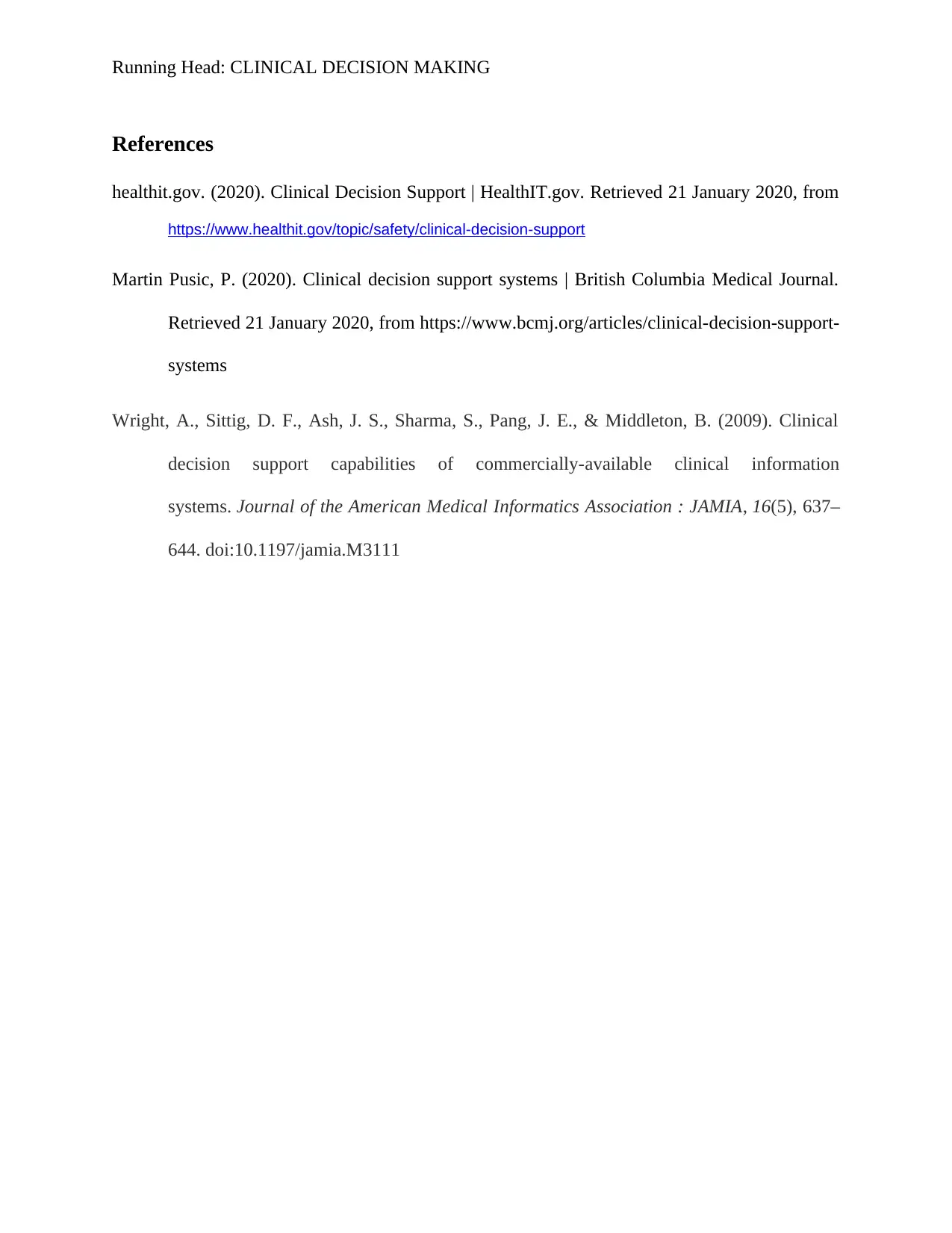
Running Head: CLINICAL DECISION MAKING
References
healthit.gov. (2020). Clinical Decision Support | HealthIT.gov. Retrieved 21 January 2020, from
https://www.healthit.gov/topic/safety/clinical-decision-support
Martin Pusic, P. (2020). Clinical decision support systems | British Columbia Medical Journal.
Retrieved 21 January 2020, from https://www.bcmj.org/articles/clinical-decision-support-
systems
Wright, A., Sittig, D. F., Ash, J. S., Sharma, S., Pang, J. E., & Middleton, B. (2009). Clinical
decision support capabilities of commercially-available clinical information
systems. Journal of the American Medical Informatics Association : JAMIA, 16(5), 637–
644. doi:10.1197/jamia.M3111
References
healthit.gov. (2020). Clinical Decision Support | HealthIT.gov. Retrieved 21 January 2020, from
https://www.healthit.gov/topic/safety/clinical-decision-support
Martin Pusic, P. (2020). Clinical decision support systems | British Columbia Medical Journal.
Retrieved 21 January 2020, from https://www.bcmj.org/articles/clinical-decision-support-
systems
Wright, A., Sittig, D. F., Ash, J. S., Sharma, S., Pang, J. E., & Middleton, B. (2009). Clinical
decision support capabilities of commercially-available clinical information
systems. Journal of the American Medical Informatics Association : JAMIA, 16(5), 637–
644. doi:10.1197/jamia.M3111
⊘ This is a preview!⊘
Do you want full access?
Subscribe today to unlock all pages.

Trusted by 1+ million students worldwide
1 out of 6
Your All-in-One AI-Powered Toolkit for Academic Success.
+13062052269
info@desklib.com
Available 24*7 on WhatsApp / Email
![[object Object]](/_next/static/media/star-bottom.7253800d.svg)
Unlock your academic potential
Copyright © 2020–2025 A2Z Services. All Rights Reserved. Developed and managed by ZUCOL.


